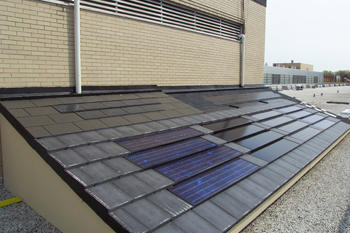Roof Photovoltaic Test Facility

In order to accurately predict the annual energy production of photovoltaic systems for any given geographical location, building orientation, and photovoltaic cell technology, models are needed that can accurately predict the response of photovoltaic systems for a wide range of environmental conditions. The Building and Fire Research Laboratory (BFRL) recently commissioned a Roof Photovoltaic Test Facility to provide the data needed to develop, improve, and validate the needed simulation models.
Specifications/Capabilities
The facility is configured to accommodate six residential (sloped roof) and three commercial (flat roof) photovoltaic roofing products. The majority of the currently installed products are referred to as building integrated photovoltaics, as they provide both protection against the elements and produce electrical power. The electrical output of each photovoltaic product is measured every 5 seconds, with average values for these quantities being saved at five minute intervals. The characteristic current versus voltage (IV) curve is periodically swept throughout the day for each test specimen. In addition to the electrical performance of the photovoltaic roofing samples, measurements are made of the coincident ambient temperature, wind speed, and solar radiation incident upon the samples. In addition measurements of diffuse and beam solar irradiance are made by an adjacent meteorological station. The nine PV roofing products being monitored fall within three general categories of photovoltaic cell technology – single crystalline, poly crystalline, and amorphous silicon – while embodying different manufacturing processes, materials, and design features. The combination of features makes each of the nine roofing products unique and well suited to capture the robustness of simulation models used to predict their electrical performance.

